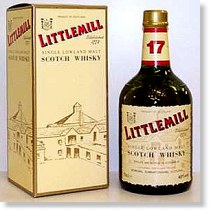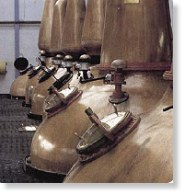| Littlemill
Single Malt Scotch Whisky
Bowling, Dumbartonshire
G60 5BG Scotland
Viewer's Comments about Littlemill
 George
Buchanan was a wealthy maltmaster from Glasgow who bought
Littlemill when he purchased the Auchterlonie estate in
1750. In 1772 Buchanan built houses to accommodate Excise
officers - this was the first official record of Littlemill's
existence. The distillery's roots however, date back much
further. According to Misako Udo, Littlemill, a Lowland
distillery, was converted from a 1750's brewery building
and, there is speculation whisky was distilled upon this
site as far back as the fourteenth century. Littlemill was
quite possibly the oldest distillery in Scotland, however,
information regarding its orgins are somewhat obscure thus
making it difficult to truly establish. George
Buchanan was a wealthy maltmaster from Glasgow who bought
Littlemill when he purchased the Auchterlonie estate in
1750. In 1772 Buchanan built houses to accommodate Excise
officers - this was the first official record of Littlemill's
existence. The distillery's roots however, date back much
further. According to Misako Udo, Littlemill, a Lowland
distillery, was converted from a 1750's brewery building
and, there is speculation whisky was distilled upon this
site as far back as the fourteenth century. Littlemill was
quite possibly the oldest distillery in Scotland, however,
information regarding its orgins are somewhat obscure thus
making it difficult to truly establish.
Throughout Littlemill's 'official' 200 year history, there
were many owners and many which were undocumented. Some
included Matthew Clark & Co. in 1818, followed by Peter
McGregor in 1821. Along came the The Excise Act in 1823
and it was Jane MacGregor who became the first licensee
for Littlemill and also one of the earliest woman distillers
in Scotland. Jane retained Littlemill until 1839. Additional
owners included Duncan McCullouch (until 1846), McCullouch
& McAlpine (1846-1847), John MacAlpine, Harvey &
Co. (1852), William Hunter and John E. Sharpe (1853), William
Hunter (1854-1857), William Hay & Co. (1857-1867), William
Hay Jr. (1869) and William Hay, Fairman & Co. (date
unknown-1874).

Littlemill Distillery Stills
|
G. Thomas, an American citizen, took over Littlemill in
1931 forming the Littlemill Distillery Co. Ltd. In 1959
Barton Brands Inc, of Chicago became shareholders in the
company and eventually bought out D.G Thomas in 1971. The
company became Barton Distilling (Scotland) Ltd.
Littlemill was closed in 1984 and four years later became
under the ownership of Gibson International. The distillery
was modernized and reopened in 1989. Ownership changed one
last time - in 1994 when Littlemill was acquired by Glen
Catrine Bonded Warehouses. It was managed by its sister
company Loch Lomond Distillery Co Ltd..
Littlemill's house style has been described as soft and
sweet, like marshmallows, and often with a 'wet grass' character.
|

